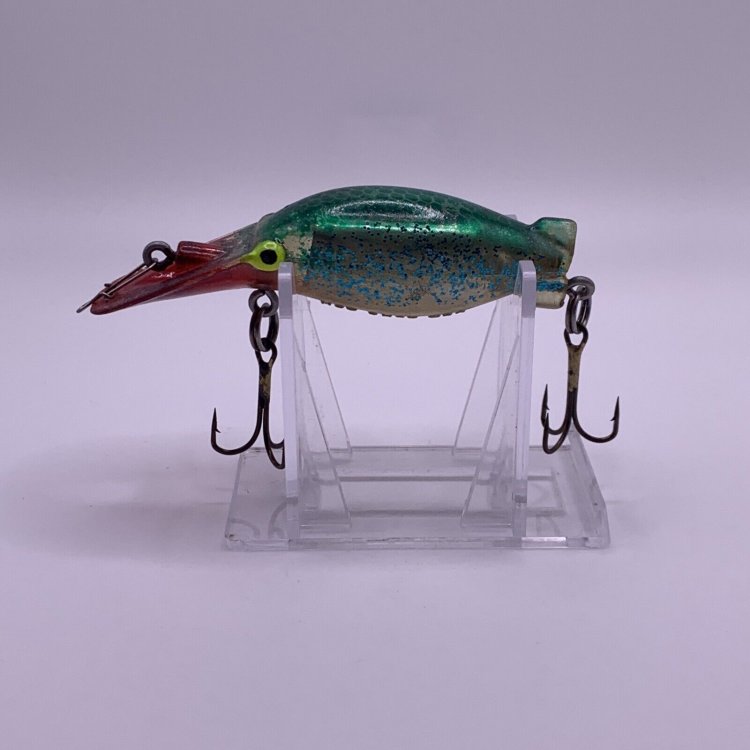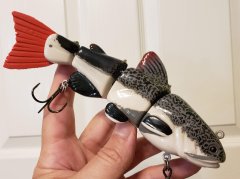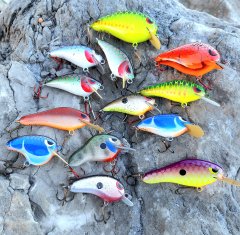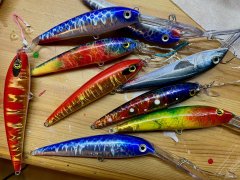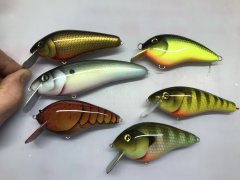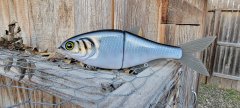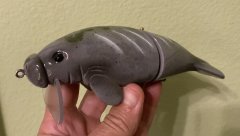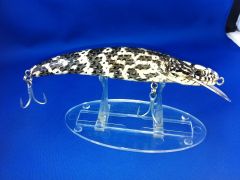-
Posts
501 -
Joined
-
Last visited
-
Days Won
4
Content Type
Profiles
Articles
TU Classifieds
Glossary
Website Links
Forums
Gallery
Store
Everything posted by Fishwhittler
-
How large are they? Are you asking about the lure in that particular color pattern, or just the lure? Without any more information, they look like pre-Rapala models in the 020 size. Found this image that seems to be a match.
-
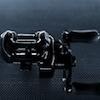
Best Fishing Reel Under 200
Fishwhittler replied to CharlesMoss1992's topic in Rod & Reel building & repair
Older Citicas (everything before the G) were phenomenal value. I own an E, D, and B, and I just bought another B for my son. Rebuilding it now with added bearings, carbontex drag and a few other goodies. The only reason I would not recommend them is that those older reels can be in rough shape and need some significant TLC. My son's reel had an almost unusable drag when it arrived, which was expected so no loss there. That reel doesn't even have Shimano's Dartanium drag washers, which are silky smooth when new but require regular maintenance to not fall apart and/or fuse to the brass gearing. Bottom line, older Citicas represent truly excellent value for the dollar. But they need some work, and if you don't work on your own reels - which isn't hard, mind you - they may not be the best choice. -
-
Don't know if they're exactly what you're looking for, but Barlows Tackle has some deep diver blanks that look similar to what you describe. Lurepartsonline is a TU sponsor and has a decent selection as well, and Janns Netcraft has some Bandit blanks.
-
-

Best Fishing Reel Under 200
Fishwhittler replied to CharlesMoss1992's topic in Rod & Reel building & repair
Ditto. I currently own 3 used Shimano Citicas of various generations. Also bought a Daiwa T3 for $200 when they were on clearance due to the T3 being discontinued. I still need a Citica 200D for my collection, and MAYBE a Citica G, but for my money the Citica D and E were some of the best value for the dollar ever produced. The only reason I'd avoid buying used is if you're not 100% comfortable with the idea of maintaining and/or repairing your own reels. Not every seller is completely honest, and buying used can be a very mixed bag if you don't know what you're looking for. -
Cut up an empty plastic milk jug. You can get a decent number of stencils out of one jug, and it's basically free if you drink milk.
-

Best Fishing Reel Under 200
Fishwhittler replied to CharlesMoss1992's topic in Rod & Reel building & repair
Apologies for the late reply. If that's the case, pretty much anything from Daiwa and Shimano is going to be good. Lews has quite the following as well, as does Abu Garcia. I will say that most low-profile reels from Lews, Abu, Pflueger, and a number of other brands all come from the same factory, though Abu's round reels from the C3 up are still made in Abu's own factory in Sweden. So as far as low-profile reels go, anything from the brands mentioned is more or less just a different iteration of the same reel. Shimano and Daiwa both make their own reels (as well as making one or two for other brands). I tend to assosciate Shimano with slightly better low-end stuff than Daiwa, while Daiwa and Shimano both have excellent top-tier options. he biggest difference between the two, IMHO, is that Shimano uses centrifugal brakes for almost everything while Daiwa tends to go for magnetic brakes. I'm partial to centrifugal brakes, though I do have a Daiwa T3 that I've no complaints about. Honestly, most reels around the $200 price point will be perfectly satisfactory and will mostly be fairly comparable. It's still going to come down to what you like the best. -

Best Fishing Reel Under 200
Fishwhittler replied to CharlesMoss1992's topic in Rod & Reel building & repair
Most metal-frame baitcast reels are at least decent. Non-metal frames aren't a deal-breaker per say, but because of the flexibility of the frame they tend to be less of a long-term investment than a reel with an aluminum frame. I've fished with two baitcasters with graphite frames, and while they work just fine and I've never had any malfunctions, under heavy load (such as fighting a fish) you can feel a tiny amount of flex that isn't there with a metal frame. Can't speak as to how much effect that has on the lifespan of the reel, but using a graphite reel with heavy line for winching is probably not going to do any favors for the reel in the long run. When it comes to brand, I'd say try to get to a store such as Bass Pro, Scheels, etc., and see how different reels feel in your hand. Then buy what you like. Most reels at a given price points are fairly competitive with each other. Bottom line, the only thing I'd really avoid is a non-metal frame. There really isn't a "best", there's just what you can afford and what you like. -
-
My solution ended up being a coat of thread sealer before topcoat, which took care of the problem. I never had problems with fisheyes when applying Etex over thread sealer, come to think of it. I had some minor issues before I started doing that, but none after.
-
I think you just explained why I was having issues at all. I never really thought about Etex containing more solvents than other epoxies, but that would explain why I experienced the issues that I attributed to uncured paint. I was using Etex when I had problems with running paint, and I had the most problems with lures that had been painted the same day as they received topcoat. If they had been painted a day or so before, the running was decreased or nonexistent. Come to think of it, I don't think I really had the same issue with running paint while using other epoxies, and I experimented with a number of rod-building epoxies for lures back in the day.
-
I rough-cut both polycarbonate and garolite with tin snips, then sand to shape with a dremel and/or a file. Works like a charm.
-
Welcome! I'd try posting your question in the Soft Plastic subforum. I haven't poured plastics myself, but there are guys on here who've been doing that for years. Offhand I'd say that for making a mold, your most common options will be Plaster of Paris or RTV Silicone. Though if you're looking for injection-type molds rather than open-pour, you'll probably need something rigid such as plaster or a hard-cure plastic. If you have a CNC or access to one, that's probably going to give the best results overall in terms of mold quality and longevity, but that's considerably beyond the price range of most hobby lure makers. For injection molding, I'd ask around about what others use and recommend. Though if you're just getting into plastic pouring, starting with open-face molds may be the simpler and cheaper way to go. Hope this helps!
-
Dang. This place has changed over the years. Managed to reawaken the old itch to both fish and build lures recently, and figured I'd see if TU was still kicking. It is, but...man, ten years is a long time. This place is much, much quieter, though I'm glad to see a number of names I do recognize still floating around. Time unfortunately has not been kind to internet forums in general, particularly specialized ones like TU. Too much commitment to long-term conversations...heh. A few of the long-standing members may remember me. Been about ten years since I was active on here to any real extent, and it's been just as long since I did any lure building (or fishing, for that matter). A bit of water under the bridge since then. Quick synopsis: Got married, had two kids, changed jobs several times until finally finding a good one I can stick with for the foreseeable future; bought a house for the first time almost a year ago to the day, and now my son is old enough that he wants to go fishing. One thing led to another with that, and I've actually started carving and painting again. Just collected most of my old lure-making stuff from storage and with a considerable amount of shock discovered how much crap I actually have. (Side note: unmixed Envirotex Lite has a shelf life less than ten years. Don't know how long, but less than ten years. Can confirm.) Now my son is in love with my old lures and stuff, so that's some fairly strong motivation to get back to it. He found an old swimbait I never finished that he's begging me to paint, and to make it blue, so that's going to be a project. Beyond that, not really much point to this except to say hi. So...Hi. Tight lines all!
-
Gonna resurrect this thread for a moment... I've never met the hook that could go through a proper coating of Etex, or any waterproof epoxy, so if you've got chipped/flaking beyond normal hook rash, it sounds like a prep or sealing issue. I've got lures that are 10 years old or better in my box, and while the epoxy is scratched, the paint beneath is intact. The only time you should experience epoxy flaking is if the seal fails, which can come from heavy impact against rocks or other hard objects resulting in cracks, chips, etc. If water can get under the topcoat, it'll do precisely what others have said and cause swelling and/or loss of adhesion. Now, another thing that caught my eye in your post is the "right after painting them" bit. Acrylic paints take time to cure, at least a day or so. A couple hours aren't really enough, nor is using a hairdryer to heat-set the paint. Dry to touch doesn't equal cured, as I learned the hard way. You might have no issues even if you do topcoat right away, but I've always found it safest to wait at least a full day before applying any topcoat. You'll really run into problems if you're using a urethane finish, which will eat right into dry but uncured acrylic paint. Never used solvent-based paints for crankbaits so I can't say for certain if there are similar issues there, but I'd imagine there are since the principles are the same. I've also found it helpful to use a clear sealer over the paint, before topcoat. I liked to use thread sealer for rod building, thinned down and applied through an airbrush. It's not strictly necessary (unless you're using U40 low-build epoxy...then it's definitely necessary), but it's one more layer of protection that helps preserve the paint and ensure everything goes smoothly. Beyond that, a few more things about using epoxy: If you want a thinner coat, try warming your lure with a hairdryer before applying epoxy. The heat will help the epoxy to flow better across the surface of the lure and will help to avoid an overly thick application. Heating your bowl of mixed epoxy can also help, but I don't really like doing that because it's more likely you'll blow dust into the epoxy and cause an annoying though harmless flaw in your finish. I've always preferred two coats for bass lures of any size. With just one coat you might miss a spot, but two coats is generally going to completely cover everything. This is especially true if you're trying to apply it more thinly, for example to preserve molded or carved details. Though if that's the case, you're better off using a moisture-cure urethane or catalyzed topcoat. Back to the original point, if you miss a tiny place or two with your topcoat, water will soak into the paint and may eventually cause the topcoat to lose adhesion and chip, crack, etc. The only time epoxy will have a noticeable and/or detrimental impact on the action of a lure is if you use way, way too much. I've used it on 1" crankbaits without issue, though if you try to go too much smaller than that you may want to consider using only a single coat or opting for a thinner topcoat option. Cranks that size are more the exception than the rule for most builders, so for anything within the normal size range for bass lures, epoxy should be perfectly fine and have no impact on the finished lure's fishability. Again, assuming you don't just go ham with your epoxy application and try to keep it to a thin, even layer.
-
-
-

00FD4EAE-E621-480E-92C8-9B6155811C65.jpeg
Fishwhittler commented on Flaswimbaiter's gallery image in Best Homemade Hardbait
-
Band saw for speed, scroll saw for precision. That's the simple version. Personally I've always preferred a band saw, but either will do very nicely. If you're using a scroll saw, I strongly advise using a sharp blade and swapping when it starts to dull. You'll also go through more blades if you're cutting thicker materials on a scroll saw. Lexan/polycarbonate is certainly possible to cut on a scroll saw, and so is garolite/Micarta. You can also just use tin snips to rough out your bills and then smooth the edges by hand or with a dremel. Personal preference; I usually did it this way because I had limited time available on my brother's scroll saw.
-
I don't really count at this point, since I'm rather dormant as a lure-builder at this moment (no workshop! I miss building...), but hopefully within the next six months or so I'll be able to get back to my old lure-building ways. I was a PVC fan-boy; loved using that stuff (funny thing, PVC dust smells better and better the more you inhale...) because I was impatient and didn't like waiting for wood sealer to cure. Or dealing with woodgrain. I think a lot of the really good builders kinda stopped coming online quite as much as the market and forums began to be saturated with knockoff lure blanks that anyone could paint and market as "custom". The skills required to build a lure from scratch are less in demand since a lot of guys, IMHO, are lazy and don't want to bother learning to build from scratch and would rather just paint something someone else made (more so in the US than overseas). Many of those who enjoyed sharing their years of knowledge and skills began to find that there weren't a whole lot of people out there who wanted to learn. So, less time online from the veterans. That's my read on it, anyway. Perhaps I'm mistaken, or perhaps things have changed again in the last few years while I've been absent from the online lure-building community. I do know that there at the end, right before I got burnt out, most of the guys who would ask for help were asking primarily about painting rather than building. Hence the deductions above. Anywhoozle. Cheers, y'all! Been a while.
-
What I used to do (and will go back to doing if/when I start building lures again) is warm the epoxy resin and catalyst separately with a hairdryer, then mix them together. The epoxy mixes better that way. One other trick - warm the lure body itself with a hairdryer when you're ready to start brushing on epoxy. Don't warm the epoxy. If the lure body is warm, it'll heat the epoxy as it is applied and thus the epoxy will spread more easily. Without heating up the mixed epoxy and shortening the work-life. Otherwise, yes, those are air bubbles from inside the balsa. Two coats of thin superglue prior to epoxy will take care of that issue. The superglue soaks into the lure body and seals the pores - I found two coats were necessary because some wood can be very porous. Plus the superglue helps harden the wood and strengthen it in a way epoxy doesn't.
-
-
-
What RayburnGuy said. I'll use black or grey base coat if I want a different look for metallic paint. I'm using Createx, if that helps. Sometimes I'll also use a black base coat when I need to cover bold colors and don't want to use a ton of white paint. Black covers faster and can then be covered with white, without needing as many coats of white.



